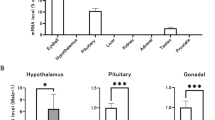Abstract
The human trihydrophobin 1 (TH1) is a highly conserved and widely expressed protein. It is clear that TH1 serves as a new specific negative regulator of A-Raf kinase. In this study, we found that TH1 associated with A-Raf in mouse testis by using coimmunoprecipitation analysis. Then we characterized the gene expression of TH1 in mouse testis and analyzed the changes of TH1 protein during postnatal development. The protein expression of TH1 in mouse testis was further analyzed by immunohistochemistry staining. Strong signals were detected in the seminiferous tubules and the distribution patterns varied with the different ages of postnatal mouse testis. TH1 was distributed in spermatocytes and Sertoli cells at 2 weeks postnatal, and was abundant in spermatogonia at 8 weeks postnatal. Leydig cells were positive to TH1 throughout testicular development. A high expression of TH1 in both Leydig cells and mouse Leydig tumor cells (mLTC-1cells) was found to be concentrated in the cytoplasm. The colocalization of TH1 and A-Raf in mLTC-1 cells or in adult testis was also observable.
Similar content being viewed by others
Abbreviations
- TH1:
-
trihydrophobin 1
- GAPDH:
-
glyceraldehydes-3-phosphate dehydrogenase
- PMSF:
-
phenylmethylsulfonyl fluoride
- ECL:
-
enhanced chemiluminescence
- DAB:
-
diaminobenzidine
- PVDF:
-
polyvinylidene difluoride
- SDS-PAGE:
-
sodium dodecyl sulfate polyacrylamide gel electrophoresis
References
Hari KL, Santerre A, Sekelsky JJ, McKim KS, Boyd JB, Hawley RS: The mei-41 gene of D. melanogaster is a structural and functional homolog of the human ataxia telangiectasia gene. Cell 82: 815–821, 1995
Banga SS, Yamamoto AH, Mason JM, Boyd JB: Molecular cloning of mei-41, a gene that influences both somatic and germline chromosome metabolism of Drosophila melanogaster. Mol Gen Genet 246: 148–155, 1995
Bonthron DT, Hayward BE, Moran V, Strain L: Characterization of TH1 and CTSZ, two non-imprinted genes downstream of GNAS1 in chromosome 20q13. Hum Genet 107: 165–175, 2000
Yin XL, Chen S, Gu JX: Identification of TH1 as an interaction partner of A-Raf kinase. Mol Cell Biochem 231: 69–74, 2002
Luckett JC, Huser MB, Giagtzoglou N, Brown JE, Pritchard CA: Expression of the A-raf proto-oncogene in the normal adult and embryonic mouse. Cell Growth Differ 11: 163–171, 2000
Wadewitz AG, Winer MA, Wolgemuth DJ: Developmental and cell lineage specificity of raf family gene expression in mouse testis. Oncogene 8: 1055–1062, 1993
Winer MA, Wadewitz AG, Wolgemuth DJ: Members of the raf gene family exhibit segment-specific patterns of expression in mouse epididymis. Mol Reprod Dev 35: 16–23, 1993
Shu PY, Chang SF, Kuo YC, Yueh YY, Chien LJ, Sue CL, Lin TH, Huang JH: Development of group- and serotype-specific one-step SYBR green I-based real-time reverse transcription-PCR assay for dengue virus. J Clin Microbiol 41: 2408–2416, 2003
Dufau ML, Mendelson CR, Catt KJ: A highly sensitive in vitro bioassay for luteinizing hormone and chorionic gonadotropin: testosterone production by dispersed Leydig cells. J Clin Endocrinol Metab 39: 610–613, 1974
Lefevre A, Saez JM, Finaz C: hCG responsiveness of purified Leydig cells from immature and mature rats. Horm Res 17: 114–120, 1983
Martinez VG, Pellizzari EH, Diaz ES, Cigorraga SB, Lustig L, Denduchis B, Wolfenstein-Todel C, Iglesias MM: Galectin-1, a cell adhesion modulator, induces apoptosis of rat Leydig cells in vitro. Glycobiology 14: 127–137, 2004
Kellokumpu S: Different processing of LH/hCG receptors in cultured rat luteal cells and murine Leydig tumour cells (MLTC-1). Exp Cell Res 168: 299–308, 1987
Kleene KC: Patterns, mechanisms, and functions of translation regulation in mammalian spermatogenic cells. Cytogenet Genome Res 103: 217–224, 2003
Bellve AR, Cavicchia JC, Millette CF, O'Brien DA, Bhatnagar YM, Dym M: Spermatogenic cells of the prepuberal mouse. Isolation and morphological characterization. J Cell Biol 74: 68–85, 1977
Malkov M, Fisher Y, Don J: Developmental schedule of the postnatal rat testis determined by flow cytometry. Biol Reprod 59: 84–92, 1998
Wang H, Chen Y, Ge Y, Ma P, Ma Q, Ma J, Wang H, Xue S, Han D: Immunoexpression of Tyro 3 family receptors–Tyro 3, Axl, and Mer–and their ligand Gas6 in postnatal developing mouse testis. J Histochem Cytochem 53: 1355–1364, 2005
Yamaguchi Y, Takagi T, Wada T, Yano K, Furuya A, Sugimoto S, Hasegawa J, Handa H: NELF, a multisubunitcomplex containing RD, cooperates with DSIF to repress RNA polymerase II elongation. Cell 97: 41–51, 1999
Narita T, Yamaguchi Y, Yano K, Sugimoto S, Chanarat S, Wada T, Kim DK, Hasegawa J, Omori M, Inukai N, Endoh M, Yamada T, Handa H: Human transcription elongation factor NELF: identification of novel subunits and reconstitution of the functionally active complex. Mol Cell Biol 23: 1863–1873, 2003
Aiyar SE, Sun JL, Blair AL, Moskaluk CA, Lu YZ, Ye QN, Yamaguchi Y, Mukherjee A, Ren DM, Handa H, Li R: Attenuation of estrogen receptor alpha-mediated transcription through estrogen-stimulated recruitment of a negative elongation factor. Genes Dev 18: 2134–2146, 2004
Liu W, Shen X, Yang Y, Yin X, Xie J, Yan J, Jiang J, Liu W, Wang H, Sun M, Zheng Y, Gu J: Trihydrophobin 1 is a new negative regulator of A-Raf kinase. J Biol Chem 279: 10167–10175, 2004
Storm SM, Cleveland JL, Rapp UR: Expression of raf family proto-oncogenes in normal mouse tissues. Oncogene 5: 345–351, 1990
Lee JE, Beck TW, Wojnowski L, Rapp UR: Regulation of A-raf expression. Oncogene 12: 1669–1677, 1996
Lee JE, Beck TW, Brennscheidt U, DeGennaro LJ, Rapp UR: The complete sequence and promoter activity of the human A-raf-1 gene (ARAF1). Genomics 20: 43–55, 1994
Skinner MK: Cell-cell interactions in the testis. Endocr Rev 12: 45–77, 1991
Kim SH, Jung KC, Shin YK, Lee KM, Park YS, Choi YL, Oh KI, Kim MK, Chung DH, Son HG, Park SH: The enhanced reactivity of endogenous biotin-like molecules by antigen retrieval procedures and signal amplification with tyramine. Histochem J 34: 97–103, 2002
Author information
Authors and Affiliations
Corresponding authors
Rights and permissions
About this article
Cite this article
Guan, X., Liu, J., Ding, F. et al. Expression and distribution of trihydrophobin 1 in postnatal developing mouse testis. Mol Cell Biochem 292, 179–187 (2006). https://doi.org/10.1007/s11010-006-9231-6
Received:
Accepted:
Published:
Issue Date:
DOI: https://doi.org/10.1007/s11010-006-9231-6




